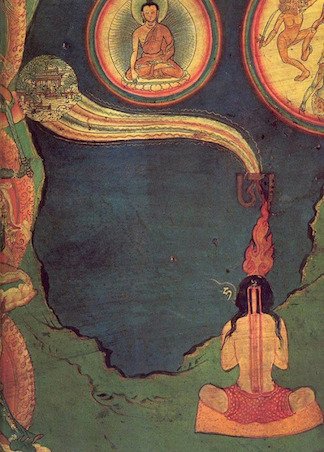

What is life after death… As long as the vayu (air and prana: or vital force) remains in the body, that is called life.
Death is when it leaves the body. Therefore, retain vayu.
Life and death in the prana?
Death is not total. This is the transmission of Vedic knowledges and yoga practice.
Life and death of the mind and body
The physical body dies, or the mind dies, but not the soul.
Death is not extinction; it is a process of disintegration.
The components of the body, the five tattwas: akasha – ether, vayu – air, agni – fire, apas – water, prithvi – earth; which are associated with the five prana vayus, disintegrate and go back to their original source.
Akasha (ether element) tattwa goes back to akasha, vayu to vayu (wind element), agni to agni (fire element), apas to apas (water element), prithvi to prithvi (earth element), and then the jivatma (the individual soul or self) moves out.
This jivatma, spirit, ego, astral body, or whatever you might like to call it, is something which survives death. The pranas also do not die, they move out of the body and return to their source. If death is to be averted the process unlinking all the three components i.e. prana, mind and soul, has to be stopped.
In this sloka, (couplet of Sanskrit verse), we are told to retain the vayu.
Vayu means air, but it does not refer only to the gross air and its chemical properties, it indicates pranic air.
The reason why we feel better after a yoga class is because we have changed our prana, or our energy body. We have moved energy (that may have been stuck in our shoulders or hips from a day of work) into different parts of our bodies, and in this way, cleared out any minor blockages that may have occurred throughout the day
What is Life?
Prana shakti is the primordial cosmic energy that governs all physical functions in our body.
Life force energy is Prana and shakti is associated with feminine and creative energy.
And one of three forms of Shakti is Prana shakti that energizes our body, mind and soul.
In the pranic body, pingala nadi channelizes prana shakti, but prana vayu moves throughout the whole body like waves of energy. It can be likened to an electromagnetic field where the energy is in constant motion.
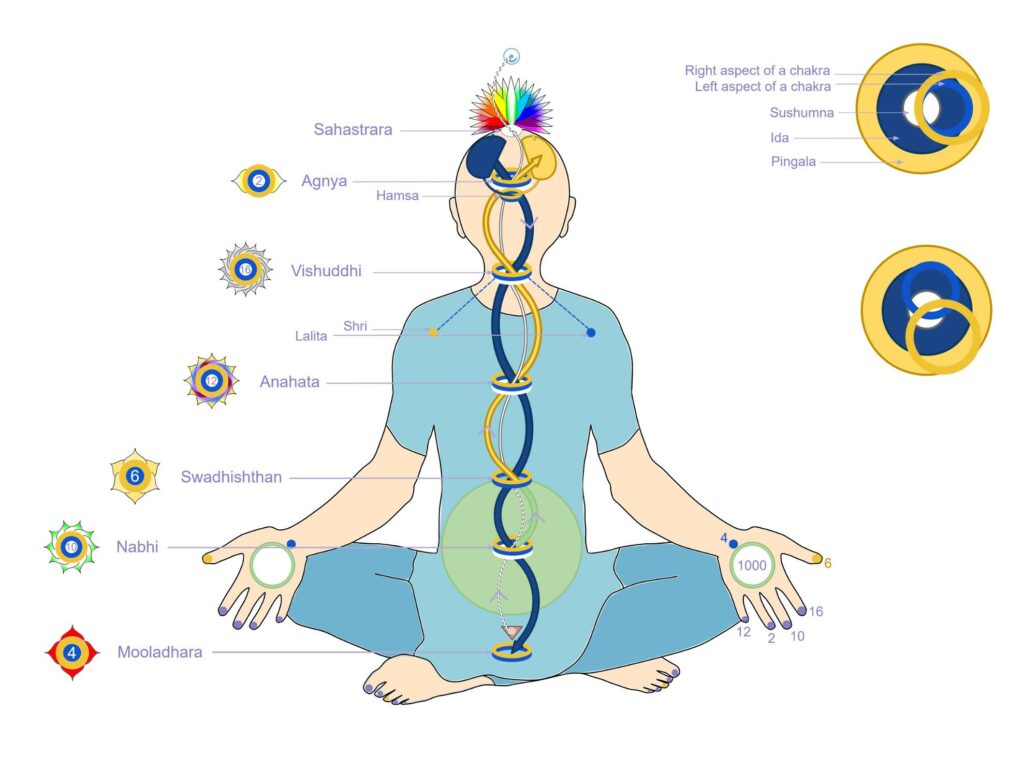
The five types of Prana Vayu
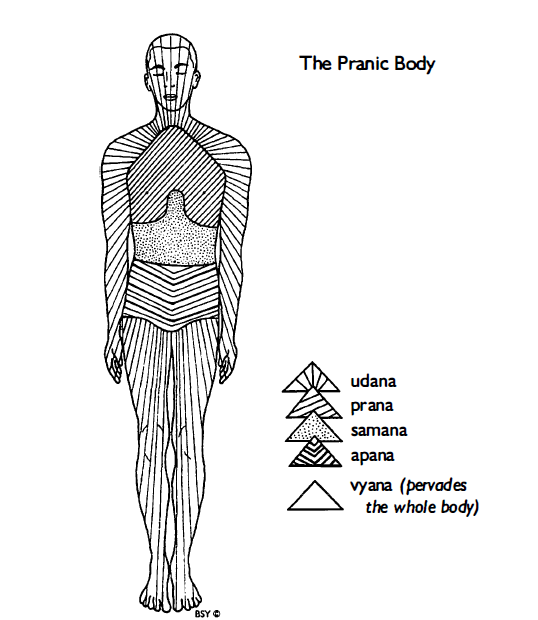
There are five main vayu functions, known as apana, prana, samana, udana and vyana.
They are the different processes and manifestations of the one vayu, just as the various limbs of a man comprise the one body.
Pranic absorption takes place on a major scale in the thoracic region and is the function of prana vayu.
Elimination takes place largely through the urinary/excretory and reproductive organs and is powered by apana.
In between apana and prana, in the stomach region, is the area of assimilation, which is the function of samana.
Movement in the throat and facial expressions are due to udana and circulation is powered by vyana which pervades the whole body.
The Pranic Body
All the processes which affect absorption or inward movement of the subtle cosmic force are due to prana.
Those which affect elimination or outward movement are due to apana.
Assimilation, preservation, and continuation are the work of samana.
Ascension and refining are the work of udana, and pervasiveness is the property of vyana.
These actions occur within the various realms of existence.
The vayu, however, is specifically concerned with the pranic body or pranamaya kosha.
Pranic body and pranyama kosha
Pranamaya kosha is the vital life energy which organises the body parts and provides movement for mental and physical expression. It allows the invisible indweller, our True Self to be able to animate in the external world
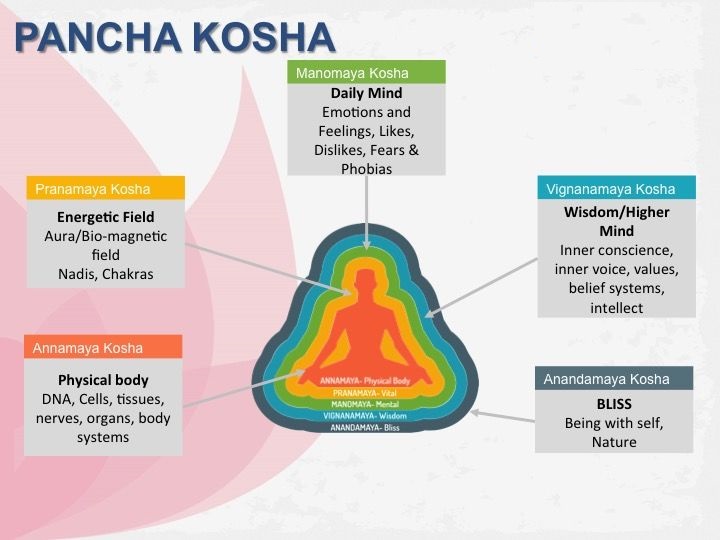
In the Upanishads, prana vayu is also called the “in breath”, apana the “out breath”, samana “the middle breath”, and udana “the up breath”.
In other words, prana vayu is inhalation, apana exhalation, samana the time between inhalation and exhalation, and udana, the extension of samana.
According to the Maitri Upanishad (11:6), “Samana is the higher form of vyana and between them is the production of udana.
That which brings up or carries down what has been drunk or eaten is udana.
From a yogic point of view the most important is:
- Vayu is samana related to sushumna nadi.
- Prana vayu is related to ida,
- Apana to pingala,
- and ascension of kundalini to udana.
Samana vayu has to be developed. This takes place by suspending apana and prana within the region of samana.
Each vayu is interdependent and interconnected.
In the Chandogya Upanishad it is asked:
How are you body, senses and yourself (soul) supported?
- On prana.
How prana is supported?
- On apana.
And how is apana supported?
- On vyana.
How is vyana supported?
- On samana.
Because of these five main movements, five subsidiary or upapranas are produced.
These are known as koorma which stimulates blinking, krikara which generates hunger, thirst, sneezing and coughing, devadatta which induces sleep and yawning, naga which causes hiccups and belching, and dhananjaya which lingers immediately after death.
What is death?
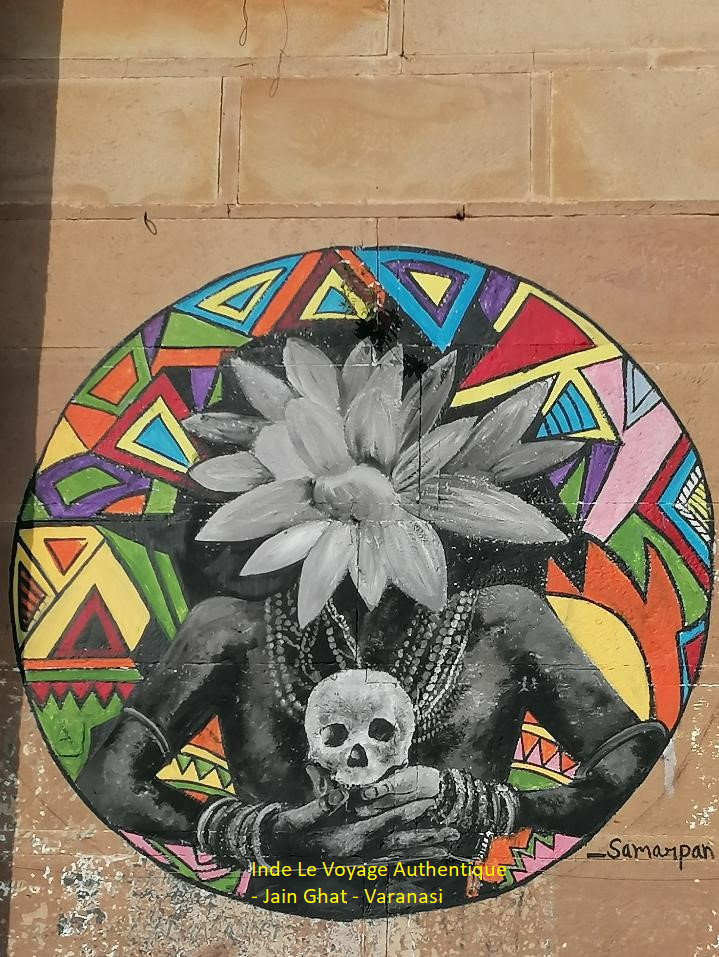
From the time of conception up until four months, the fetus survives purely on the mother’s prana.
After four months it is said that prana enters the fetus and individual life begins. As the individual pranas begin to move, so the individual body functions become active. However, the child is only independent once it is born and starts breathing.
The moment prana completely leaves the body, consciousness departs, because prana and consciousness are the two poles of the one source, the Self.
The Prashnopanishad says, “This prana is born of the Self. Just as there can be a shadow when a man is there, so this prana is fixed on the Self…” (3.3)
At death, when the breath stops and the prana leaves, the magnetic force which held the body together deteriorates and along with it, so does the body. Therefore, the breath and prana are likened to a thread in the Brihadaranyaka Upanishad, verily by air, as by a thread, this world, the other world and all beings are held together.
Therefore, it is said, when an individual dies his limbs have been loosened because they are held together by air like a thread.”
When prana leaves the body there is no force to animate it. As long as prana is retained the body will not die.
What generates life?
Life is generated with inhalation, with exhalation there is loss of prana. When the breath is held, the prana does not move out or in, it becomes stabilized.
Prana is the basis of life and can be directly controlled through the breath.
The yogis who go underground for days together in a place where no air can penetrate, completely stop the breath.
These yogis concentrate on the prana as a point of light in the mid-eyebrow center. When their consciousness is completely absorbed in that light, the breath stops automatically.
Prana remains in the body, but there is no breathing process. There is no absorption of prana, no elimination, no function of prana and apana; only of vyana. The body functions are suspended as long as consciousness remains absorbed in the point of light. It is a state of suspended animation.
The moment the awareness starts to come back to the physical body, the breath starts and the yogi has to come out.
Through the breath, prana and consciousness are essentially linked; they can be separated by a scientific means which starts with the yogic technique of learning to retain the breath.
Prana is the tangible manifestation of the higher Self and Hatha yoga uses prana as the key to expand the awareness of consciousness and realize the Self.
Some systems of yoga aim at self-realization by purifying and concentrating the mind, others by purifying and channelizing the emotions, and some by purifying the intellect and developing wisdom.
There are so many ways of redirecting the vital life force from the lower to the higher centers.
Hatha yoga achieves it by a means which is most practical for everybody through the physical body and by working directly on the pranic movements.
References:
Pranayamas and Their Neurophysiological Effects
Oxygen Consumption Changes With Yoga Practices A Systematic Review
Prana: The functional basis of life

